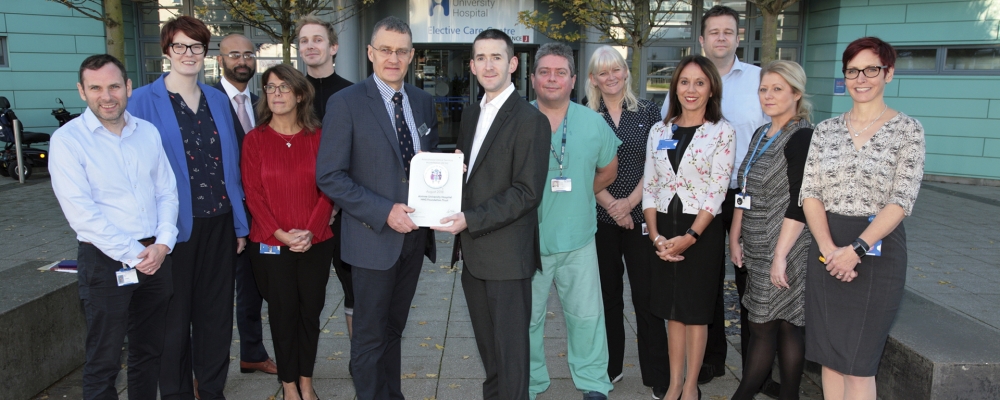ACSA at Liverpool University Hospitals NHS Trust (formerly Aintree)
When I took up my post as consultant anaesthetist, I fell into the trap of saying ‘yes’ when asked to become ACSA lead, without really understanding the process or role in question.
What do I wish I'd known?
There have been a number of challenges that were not fully appreciated by the department prior to starting the ACSA process. The workload arising from the ACSA process is significant and requires a substantial time commitment. I had agreed to take on the lead role without fully realising the commitment required and the workload involved. I know that in other departments colleagues have shared the role and this has worked very well, and I would strongly suggest that larger departments follow this model. When a department is embarking on the accreditation process, I would encourage the department’s senior management team to attend an ACSA event run in conjunction with ACSA accredited departments. This was extremely helpful for us in gaining the support required to make the necessary changes to meet the standards and ensuring that we had ‘buyin’ from the division as a whole. Having the support of the rest of the multidisciplinary team enables much greater progress to be made than if things are kept within the anaesthesia department alone; if everyone can see the benefits, then they will be more willing to help (securing funds for training, for example). I wish that I had used our College guide more. They are an extremely useful resource with an in-depth understanding of the process, and they can help to solve problems very quickly and easily, as well as just being an ‘ear to bend’.
When a department is embarking on the accreditation process, I would encourage the department’s senior management team to attend an ACSA event run in conjunction with ACSA accredited departments. This was extremely helpful for us in gaining the support required to make the necessary changes to meet the standards and ensuring that we had ‘buyin’ from the division as a whole.
How did we do the gap analysis?
For us, the process was started around 18 months before formal engagement. We were able to collate evidence and close the gaps significantly before we made any financial commitment. I led the gap analysis myself, as well as commencing the closure of the gaps. Once we started to make progress, it became clear that the level of work was too great for one person to do unaided, and so work to close the gaps was spread more widely across the department. This encouraged greater cohesion across the department, as we could demonstrate more clearly what we were working towards.
How did we get the funding?
The ability to make progress with the ACSA standards prior to formally engaging with the process is a huge positive, as it enables trusts to assess themselves and demonstrate progress towards meeting the standards before having to make a financial commitment. This strengthened our argument for funding. As a trust, we had recently been through a CQC inspection, and the ACSA process was seen as a method of ensuring quality was improved and maintained within anaesthesia and theatres. This, coupled with the relatively low cost in comparison to other trust investment ideas, was seen as a positive way forward to ensure quality was maintained. It did help that our medical director (an anaesthetist) was on board from the start and was keen to use our department as a model for the trust.
What were the biggest challenges?
Although we had initial difficulties with some of the larger areas which needed cross-specialty cooperation (diabetes and haematology were two examples), once discussions had been held, the support from our colleagues was brilliant. By demonstrating how changes and cooperation can improve patient care and potentially reduce the workload of those specialties, there was a very rapid move to make positive changes. Where we struggled most as a department was in our own areas. Full agreement was often hard to come by, and we sometimes had repeated discussions about how policies and guidelines were worded, or how workstreams and processes were implemented.

How did we benefit?
On a personal level, as someone who started this process as a new consultant, it has very quickly enabled me to build relationships with other specialties in the hospital. I have also gained a huge amount of experience with many areas in hospital and management that I would not necessarily have understood prior to this. As a department, we certainly feel that we have benefited from the process. We have filled gaps in our knowledge, as well as expanding the training opportunities for our medical staff, and also for our support staff – who previously felt undersupported. The accreditation visit itself was (relatively) painless and very constructive, even with the initial feedback at the end of the visit. The visiting team very quickly make the point that it is a quality improvement process, and I cannot thank them enough for their help during the visit or their help during the visit or their ongoing encouragement since. The support offered by the College itself has been incredible and the response to questions and queries for help has always been excellent. The use of the library of good practice has been one of the strong points of the process to help us close gaps. Using ACSA as a lever has enabled me to provide evidence for funding in several areas, as well as the support required to ensure that training opportunities are provided to nonmedical staff. We will continue to use this ACSA guidance, as well as information from our report, to ensure that we get the appropriate resources required to maintain our service and to ensure high quality anaesthesia is provided.

ACSA Lead, Aintree University Hospital NHS Foundation Trust
